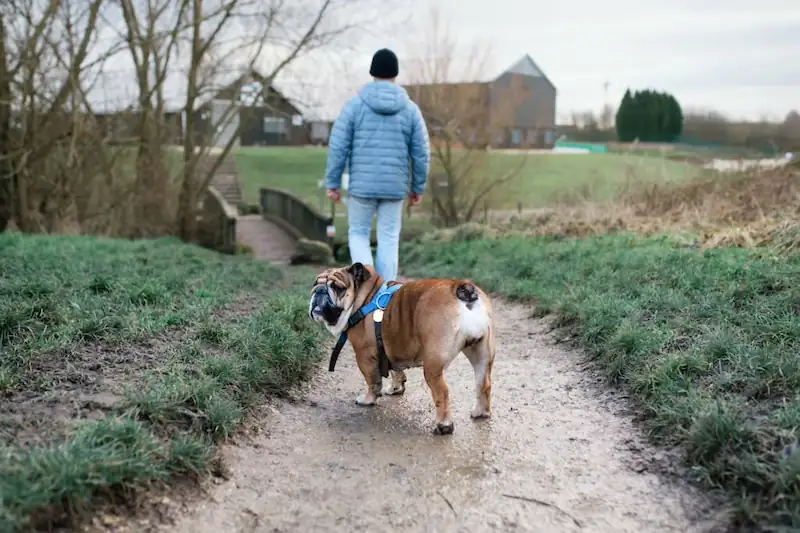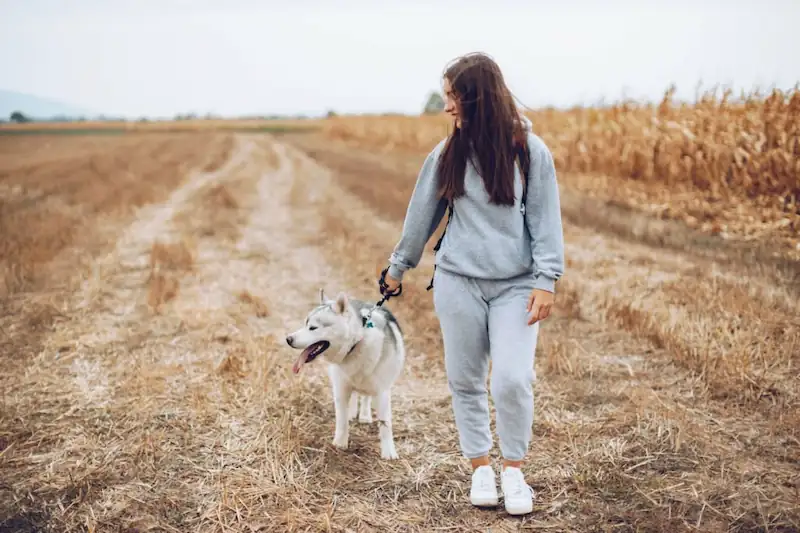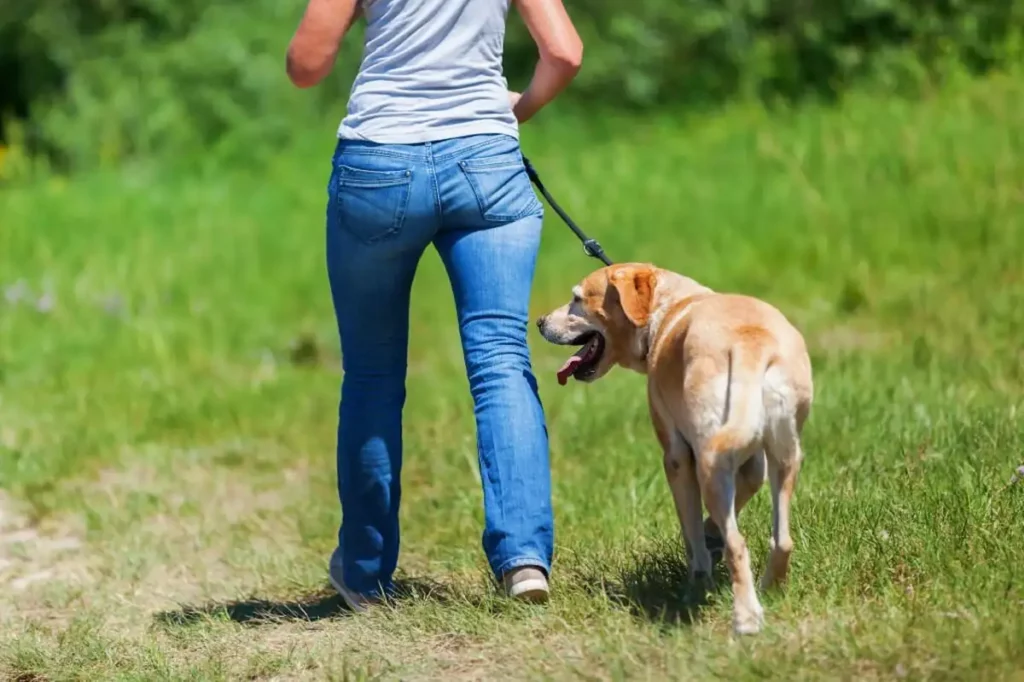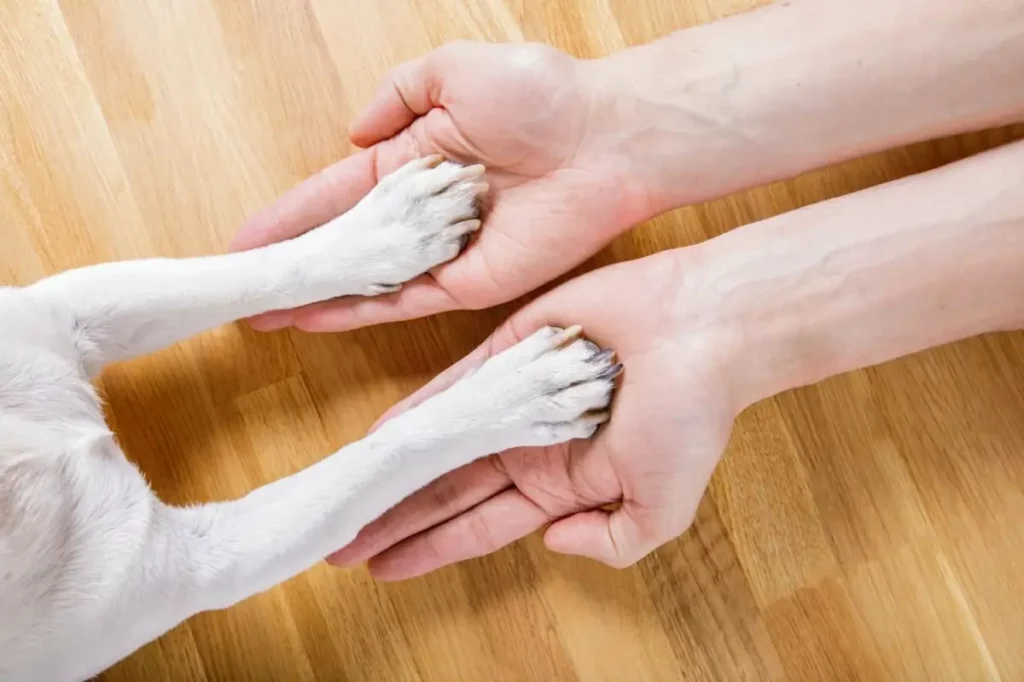Walking your furry friend is probably one of life’s greatest, albeit most simple, pleasures. It can be a great time to build on the human-dog bond you share, explore together, or just enjoy the sights and sounds all around you.
In a fur-perfect world, your canine companion will keep step, while proudly and gallantly walking beside you. But nope, not Fido! He insists on lagging behind, following closely but at a sluggish pace. It’s a fair question, one surely asked by dog owners worldwide – why does my dog walk behind me?
A dog walking behind you can be due to his curiosity to interact with his surroundings. When he is in unfamiliar places, it makes him feel uneasy so he is taking his time to assess the environment. Since he views you as the leader, walking behind you reassures his safety.
While it is not one of the earth’s most serious problems to have, it can be frustrating, particularly if you have a multi-dog household – all of which trying to travel at different speeds.
Today, we focus on the slowpoke of the family. Most people would rather deal with this behavior than have Fido drag them around the block, but aside from being slightly annoying, it is important to pinpoint, which of the many possible reasons, applies to your specific pooch and to rectify the situation if need be.
Related also: Why Does My Dog Sit Under My Chair?
Why Does My Dog Walk Behind Me?

13. He Is A Bit Too Curvy
A dog’s bone structure, well their whole anatomy actually, means that even just a few extra pounds can cause some pretty serious health issues. The added weight can cause hip, joint, and back pain, diabetes, and in the most serious of cases, deadly heart disease.
The heavier they are, the more easily winded they get as well. Your favorite furball might be lagging behind because he simply can’t keep up. Be consistent with the exercise and remember to be patient, as the pounds will start to slowly melt away and he will be able to keep up a quicker pace.
12. Fear
Some dogs tend to be more fearful than others. And this can be very much compounded by past situations, such as neglect or abuse. Loud noises, an overabundance of strange new smells, and you just might have a recipe for a total scaredy-dog.
Reassurance from their favorite human could go a long way in easing his fears. This particular emotion is typically deeply ingrained so it might take a bit of time but eventually, he will feel more comfortable, and less fearful, on your walks together.
11. He Is Being Conditioned To Do So
Our furry canine friends learn best by conditioning as well as by positive reinforcement. If your dog was once a ‘puller’ and needed to be trained to not drag or tug during walks, that could be the reason for him trailing behind you.
He has simply been conditioned to do so. Good news for you – This is an easy fix and simply requires a bit of persistence. During your walks, encourage him to walk right next to you and when he does as he is told, offer him a treat, a gentle pat on the head, and an enthusiastic ‘Good Boy!’.
10. He Is Being Submissive

While some may disagree, many dogs do live with a ‘pack’ mindset. Basically believing that you are the ‘alpha’ or leader of their pack. As his appointed leader, it is natural for him to be submissive to you. He knows darn well who feeds him!
If your pooch continually chooses to stay a few steps behind you, it might just be his way of showing you that he is submissive. If you believe that this is possibly the reason for his walking behind you, be careful trying to correct it as doing so may confuse him and undermine previous training.
Related also: Why Does My Dog Bite Me In The Morning
09. Unfamiliar Territory
Some, not all, dogs get skittish, almost paranoid, in new and unfamiliar surroundings. You as his ‘alpha’, are the one comforting presence, his protector, so naturally, he would hide behind you if he feels uneasy, he knows that you will keep him safe. The only real solution here would be allowing him to get acquainted with the area you want to walk him in.
08. Anxiety
Much like humans, dogs are capable of feeling stressed or anxious, and sometimes a walk can trigger these feelings. If your dog is feeling nervous it is not surprising that he is choosing to let you take the lead.
Time, positive reinforcement, and consistency will likely help ease anxious feelings. If it is severe, you might want to consider asking your veterinarian for available medication.
07. Stopping To ‘Smell The Roses’
Pretty much all dogs like to explore and investigate new smells, sights, and sounds, they are just inquisitive by nature. Some more so than others, and your dog just might like to investigate and explore things a little more in-depth than other dogs. Allow him to get a decent whiff but then gently prompt him to move along.
06. Personality Quirk
The more we learn about our canine friends, the more we realize how individualized they really are. Every dog has its own character, personality, and quirks, and breed, experience, and background can all shape how your dog views the world. For whatever reason, or even none at all, your dog might just enjoy following as opposed to leading.
05. Herding Mentality
Certain dogs and breeds, particularly herding dogs, feel compelled to be the ‘herder’ of the pack. In this instance, your dog might even nudge legs or nip at heels to keep everybody moving. Considering many times this is almost hard-wired into their DNA, this will likely be a difficult habit to break.
Related also: Why Does My Dog Nibble My Ear? Here Are The Reasons
04. He Is Simply Getting Older
The age of your dog must also be taken into consideration. If yours is an older pooch, him walking behind you during excursions (especially prolonged ones) could very well be because he simply can’t move as fast as he used to.
He could also be suffering from an age-related medical issue such as hip or elbow dysplasia or arthritis. If he is older and is showing any other signs (lethargy, malaise, abnormal aggression) then it might be wise to have him checked out by the veterinarian and treated accordingly.
03. Attention Seeking Behavior
If your dog not only seems to prefer walking behind but also occasionally manages to trip you up, it might be down to attention-seeking behaviors. If this happens it needs to be nipped in the bud. Reinforcing this behavior could cause future behavioral issues. A firm “No” and making him stay until he walks next to you should help to get your point across.
02. Lack Of Confidence
Walking behind you is a classic sign of a dog who is lacking in self-confidence. This could have been caused by a number of different things but thankfully, it is relatively easy to build that confidence back up. Offering encouragement, reassurance, and general, but constant, praise will help get him back to feeling like the super pup that we all know him to be.
01. Underlying Medical Condition
And here we are fur-moms and dads. This is the one that we need to be the most cautious about. Walking behind the ‘pack’ could be due to an underlying and possibly serious, medical condition.
Depending on the breed, age, and overall health of your pet, this could be something as mundane as arthritis or something more serious like cancer.
If he is showing any other symptoms like loss of appetite, whimpering, vomiting, and/or diarrhea, or even if you are just concerned, take him to the vet. It is better to be safe than sorry, particularly with regard to our precious pets.
Should It Be Allowed?
As with anything, any behavior that you deem unacceptable should be corrected, however, you should also consider what the actual cause of the behavior is before committing to treatment or retraining.
So long as the pulling is not something that has become dangerous, ie: pulling with excessive force, then whether or not it should be allowed can be determined on a case-by-case basis.
Related also: Why Does My Dog Sleep On My Pillow?
How To Train Your Dog To Not Walk Behind You

Once you have determined that the behavior needs to be corrected, you can start taking the steps to do so. Using a harness or short leash, gently guide your pooch to walk with you.
Slow your speed if he seems to be dragging. It is important to not make him associate it with a negative experience. Stay calm (yes, it can be frustrating), yelling and/or getting upset will only cause fear and inhibit training.
Use treats and positive reinforcement when he seems to obey or pay attention. It might take some time but he will eventually get it.
Tactics You Should Never Use:
- Fear or Intimidation: Not only are you teaching your dog to fear you but guess what many fearful dogs do? Yeah. They bite. So unless you want to introduce aggression into your relationship, leave the yelling for the human children (kidding!).
- Yanking or Dragging Him: Pulling on your dog, especially if he is wearing a regular collar, is dangerous. It will choke your dog. Would you listen to someone who is basically assaulting you?
- Specialized Collars: While you might be tempted to use a choke or electric collar, just don’t. You might think that pain is a good motivator but it is also a good reason to eat your face in the middle of the night.
As with most things in this crazy little thing called life, you catch more bees with honey than vinegar. Teaching Fido to associate you with negatives (fear, pain, anxiety) will only make his behavior worse and your job much, much harder.
Final Thoughts
In the grand scheme of things, Fido taking the lead certainly isn’t the worst thing that could happen. And, luckily, it is easy to change if you choose to do so. But before you do that, it is important to get to the root of the problem, just in case it is something that needs further attention.
Allowing or encouraging the behavior is a completely personal decision and if it is not causing any issues then it isn’t something that absolutely has to be corrected.
Honestly, maybe we could all learn a thing or two from our beloved four-legged family members, perhaps they have had the right idea (and attitude) all along, and we probably all could benefit quite a bit from slowing down and actually taking it all in.
FAQs: Why Does My Dog Walk Behind Me
Q: is it normal for my dog to walk behind me?
A: Yes, it’s normal. Many dogs naturally walk behind their owners as part of their instinctual behavior and pack mentality.
Q: How can I train my dog to walk beside me?
A: Use positive reinforcement and reward-based training. Offer treats or praise when your dog walks beside you, and be consistent in reinforcing this behavior.
Q: Should I be concerned if my dog always walks behind me?
A: Not necessarily. While it’s usually normal behavior, monitor for signs of distress or health issues. If in doubt, consult with a veterinarian.
Q: Can I teach an older dog new walking habits?
A: Yes, older dogs can learn new behaviors through consistent training. Be patient and use positive reinforcement to encourage the desired walking behavior.
Q: When should I seek professional help for my dog’s walking behavior?
A: If you observe persistent signs of stress or anxiety, or if the behavior is challenging to modify, consulting with a professional dog trainer or behaviorist is advisable.



